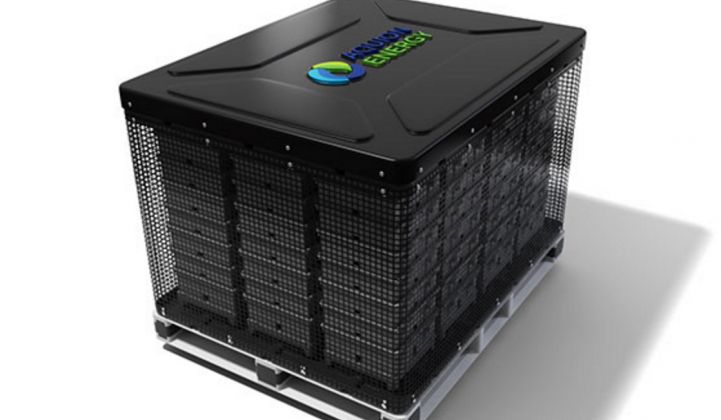After four months in limbo, saltwater battery maker Aquion is back in business.
Juline-Titans LLC acquired the bankrupt Aquion at auction for $9.16 million on June 20. That price beat out a stalking-horse bid of $2.8 million from Austrian energy storage firm BlueSky Energy. Aquion announced a resumption of operations July 21.
The good news: This nontoxic, long-duration alternative to lithium-ion technology has another shot at scaling up sales.
The bad news: $9.16 million is just a fraction of the $190 million in venture capital and debt the company had raised from investors including Bill Gates, Gentry Venture Partners, Kleiner Perkins Caufield & Byers, Foundation Capital, Bright Capital, Advanced Technology Ventures, Trinity Capital Investment and CapX Partners, Yung’s Enterprise, and Nick and Joby Pritzker.
Calls to the company’s new media contact were not returned in time for publication, and the company website returns an "Oops!" error message, so new details are scarce regarding any strategic changes.
Even the new leadership remains a mystery. The CEO named in the press release, Philip Juline, has no online presence to speak of. He does not appear on LinkedIn, Twitter, Facebook or in any previous media interviews. There is, however, a LinkedIn profile for a Philip Zhang who is listed as CEO of Juline Capital.
His statement in the company's announcement signaled more continuity than difference.
"We are refocused on technology and go-to-market opportunities that will grow significant volume for the company in the coming years," Juline said. "We now need to focus on what we do best -- creating the safest, cleanest and lowest-cost per kWh-cycle battery technology in the world -- with a simple business model that can effectively compete in the marketplace."
He also called for "renewed focus" on China and global markets.
The new corporate owner is another source of mystery. Juline-Titans, which registered in Delaware on May 30, is an affiliate of a Chinese investment holding company, China Titans Energy Technology Group, which specializes in power electronics. The more recent announcement, though, refers to the new investor as "a majority-American joint venture."
The terms of the contract suggest the new owner will pull the assets out of the existing factory near Pittsburgh, the Pittsburgh Post-Gazette reported.
Here's what we do know about the company's status.
Aquion had achieved 250 deployments with a cumulative 35 megawatt-hours globally. It targeted long-duration, long-life applications, with a special appeal for microgrid and off-grid applications. Highlights include a 1-megawatt-hour system backing up the residence and working farm of Medtronic founder Earl Bakken and a roughly 350-kilowatt-hour installation at an organic winery and farm in Sonoma, Calif.
The company built a full-fledged factory outside of Pittsburgh capable of producing 200 megawatt-hours annually, well more than Aquion has manufactured thus far.
To outside observers, the decision to invest early in a large manufacturing facility may look foolhardy. Plenty of other battery companies have gone bankrupt after completing expensive factories of their own. Aquion, though, made a bet that controlling their means of production offered a better shot at achieving the cost declines needed to stay competitive.
The unexpectedly rapid declines in lithium-ion battery costs -- more than 50 percent in the last three years -- undercut those cost-curve plans Aquion made several years ago. That will still be a challenge under new ownership.
If anything has changed, it's that long-duration alternative chemistries have gradually become more familiar. Every additional month of real-world run time helps.
The strong track record of sales indicates Aquion can find buyers for this technology if it searches far and wide. The thing it didn't have was money; it had grown too big for VCs to keep pumping in cash, but wasn't big enough to attract private equity or other deeper pockets.
The key to a successful reboot lies in the willingness of Juline-Titans to pony up for operational costs until the pipeline really takes off. With minimal data on the skill or inclinations of this new ownership, it's hard to say what will happen next.



